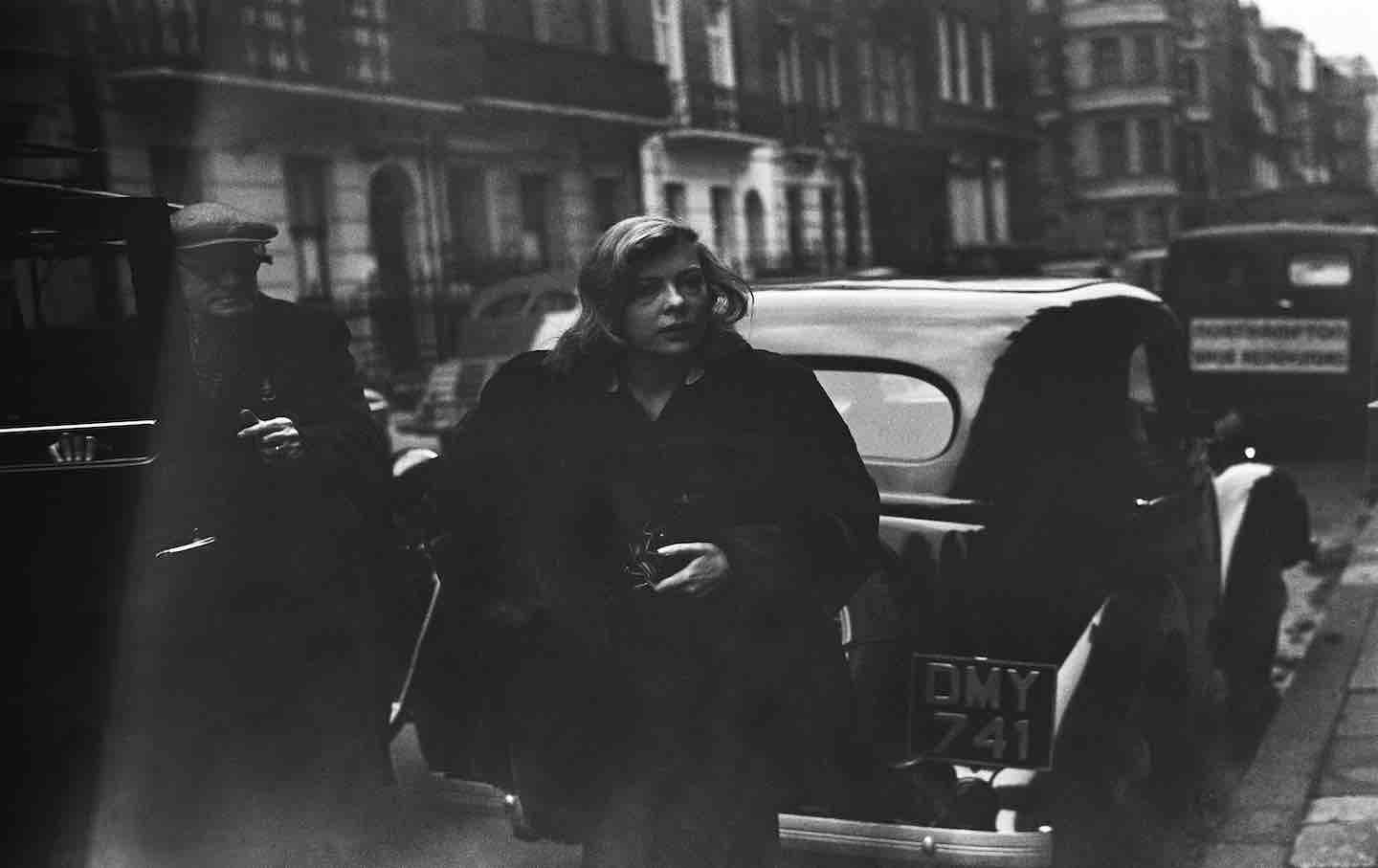Caroline Blackwood’s Graceful Nightmares
The writer and socialite’s gothic fictions were also cutting works of social comedy.

Caroline Blackwood, 1953.
(Evening Standard / Hulton Archive / Getty Images)
When Lady Caroline Blackwood walked through the graveyard that housed her ancestors, she felt tortured by fate. Death came for members of the Guinness family too frequently and too early. The sports cars of relatives had rammed into walls or swerved into oncoming traffic; an aunt had jumped off an aqueduct in Italy. Then there were the overdoses, the sudden illnesses, even an assassination. Blame was placed on a family curse: Perhaps the maintenance of such wealth and power—from all the beer barons, bankers, and politicians the family had produced—was only possible through the occasional blood sacrifice? Though Blackwood would write about royal intrigue, dusty estates, and decrepit countesses terrorizing anyone nearby, the curse she was most interested in was not exclusive to the privileged. It was one we all carry, to which no person is immune: having a mother.
Books in review
-
The Stepdaughter
Buy this book -
The Fate of Mary Rose
Buy this book
Two recent reissues of Blackwood’s work display the breadth of her cursed maternal relations. The Stepdaughter (1976), her debut novel, gave us the first of Blackwood’s many monstrous mothers. Four years before the book’s original publication, Blackwood had married Robert Lowell, who at the time was stitching together stray bits of verse and the anguished letters of his ex-wife, Elizabeth Hardwick, for his poetry collection The Dolphin (1973). The Stepdaughter would prove a cruel, epistolary work of a different kind.
The novel is the story of J, an amateur painter holed up in her gorgeous, giant New York apartment—the only worthwhile asset left over from her failed marriage. J’s lawyer husband, Arnold, has run off with a young Frenchwoman and has neglected to take along Renata, his frumpy 13-year-old daughter. Unspoken but implied is that Arnold will let J keep the apartment so long as their 4-year-old daughter Sally Ann and, more crucially, Renata are cared for—though the childcare duties are largely palmed off on another Frenchwoman, a young au pair named Monique. The Stepdaughter is made up of J’s tirades, shoved into the shape of raging letters to no one, that she writes in her head: “Dearest… Today is a Sunday. Sundays are always my worst days. Renata has no school.” The style is characteristic Blackwood: pungent and compact, with sentences that land like an axe.
At first, J’s imagined letters are nominally aimed at Monique. J is horrified by her youth, her hopes, her tanned, slender arms and quaint cooking. But in reality, J rarely addresses Monique at all, apart from the odd command, leaving the au pair to converse with her toddler: “When she tries to communicate with Sally Ann, it’s with the desperation of some prisoner in an ancient dungeon who tries to save his sanity by talking to the rats.” We learn that J has commenced her internal letter-writing to counter Monique’s compulsive scribbling of sad missives (“la femme ici est abominable”) to her friends back home, which J has discovered by reading over her shoulder.
But Monique is a minor diversion from J’s main source of disgust, Renata, and the letters are merely a forum for her to soliloquize about the oppressions that have befallen her. Her stepdaughter’s existence, for one, produces a laundry list of offenses: Renata uses an obscene amount of toilet paper, routinely clogging up the bowl. Renata is frightened of kettles, insects, and cats. Renata is ugly and overweight, lacking style. Renata is stupid and missing something elemental, “a lobotomised misfit.” Renata’s sole joy is pathetic: cooking packaged cake mixes, gazing in awe at the resulting rock-hard mounds, seemingly thinking of herself as some sort of artisanal baker. It is for this particular habit that J’s (and Blackwood’s) language is at its most ruthless: “Recently she has been baking far more than her usual quota of instant cakes. Now, when she gobbles them down, it’s as if she is hoping that in some camel-like way her body will be able to store them up and enable her to survive the desert future she fears must lie ahead.” Naturally, J looks to newspaper images of bomb craters and wounded children for momentary relief.
To be perversely thrilled by the brutality lobbed at an undesired teenager is one thing, but to be drawn to side with the teenager’s oppressor is something else entirely. The sly genius of The Stepdaughter is how we’re reeled in to sympathize with J’s lunatic logic and victim complex. Reading the novel has the same effect of being sucked into a conversation with a charming egomaniac. Only later, away from the pull of their vortex, do you realize the depths of their single-mindedness and savagery—that their complaints don’t warrant their theatrics; that it wasn’t exactly a conversation, but rather a self-pitying, raving spiel.
Later in the novel, when Renata disappears after revealing that she isn’t really Arnold’s biological daughter, J is forced to turn back to herself. Without Renata, the story that J has told about her life—all the betrayal and thwarted ambition—loses its solid shape. Unlike the impotence that marks many of Blackwood’s characters, J is spurred to retrieve Renata, the loss of burdensome family ties finally freeing up the space for sympathy and care.
Blackwood likes the hard, thick lines of caricature: the evil grandmama, the merciless hospital matron, the self-obsessed socialite lacquered in makeup, the weaselly male cuck. But inside those inky borders, she brings to bear horrid realities. In The Stepdaughter, it’s the fortifications we build out of deflection and preoccupation, funneling all our torments into a single, easy source; how we perpetuate the pain of being unloved by passing it on to others. Blackwood’s fiction is a playground for human ugliness in which she gets to be the bully, manipulative and cunning, pulling down the pants of her characters to expose their shameful natures.
All of Blackwood’s novels are domestic, zeroing in on the prisons we build for ourselves, at home and in marriage. “In the center—one could say the vacant center—of the reverse magnetic field that Blackwood’s men and women create between them is an abstraction called ‘the family,’” noted the writer Gary Indiana. Guilt, pointless decorum, and a good deal of ambivalence are the glue that holds these miserable arrangements together. The animosity is not only shared between wife and husband but travels down the familial line. Repeated across Blackwood’s stories is the anguish felt by parents who must contend with their boring, dopey children. But above all else it was the mother—who is supposed to love and care, but can only ever wound—who remained her favorite villain.
The gothic flavor of Blackwood’s fiction stemmed from childhood, where great privilege curdled with deprivation. She was born in 1931, to parents of titled gentry: Maureen Constance Guinness and Basil Sheridan Hamilton-Temple-Blackwood, the marchioness and marquess, respectively, of Dufferin and Ava. Blackwood was 13 when her father died, blown up by a Japanese mortar shell at the tail end of World War II. Her mother stuck around but was barely there, always fleeing the countryside to socialize in London. Blackwood never got over her mother’s contempt and indifference. The family lived in a sprawling, rotting estate in Ulster called Clandenboye, where Blackwood and her sibling were cared for by a succession of despotic nannies, with the worst of them fond of withholding food and starving her charges. Blackwood’s youth coincided with wartime in Northern Ireland, a preoccupation of her early stories, where the boredom was punctuated by toothless horse instructors, violent school teachers, and a mad grandmother steadfast in her belief in fairies. After the war, when Blackwood came of age, she was quickly placed on the assembly line for marriageable aristocrats: finishing school, debutante balls.
Much of her life seemed to move between total renunciation of this upper-crust upbringing and grand entitlement (she always insisted upon the “Lady” honorific). She managed to weasel her way out through marriage, where she aligned herself with those seen by her family as unsuitable, whose lives and art she admired. Blackwood met her first husband, Lucien Freud, in 1949, at a socialite’s party in London—he was standing next to Francis Bacon, who was busy booing Princess Margaret for an excruciating performance of Cole Porter songs. Blackwood was the subject of Freud’s early expressionist portraits, with delicate strands of gold hair and eyes like fishbowls; the relationship ended less tenderly. In its aftermath, Blackwood went to Rome, where she had an affair with the film producer Ivan Moffat and then in the mid-1950s followed him to Hollywood. She thought she might try her luck at acting. It was a bust, but LSD psychotherapy, encouraged by Cary Grant, appears to have activated her writing abilities.
Blackwood then moved to New York, where she hung out with Walker Evans, dabbled in modeling, and married the pianist and composer Israel Citkowitz, a great talent who, to Blackwood’s chagrin, could never fulfill his promise. She left him in 1966 and returned a few years later to the UK. A story from this period is telling of the particular glee that Blackwood got out of pranks. While she was in London, her New York apartment had been unwittingly leased out to what she described as a “prostitution ring,” the phone ringing off the hook with johns and their requests. As a gag, Blackwood decided to forward the calls on to the office of Robert Silvers, the editor of The New York Review of Books and her recent lover turned friend. Silvers would be the one to introduce Blackwood to Lowell, but they wouldn’t get together until 1970, four years later. Their marriage was chaotic, beset by Lowell’s frequent bouts of mania and yearnings for his ex-wife. In 1977, Lowell died in a taxi outside of Hardwick’s apartment while clutching Freud’s painting of Blackwood, Girl in Bed.
Blackwood’s home life, from her first marriage to her last, was squalid—full of sloppy food, children, friends, and empty vodka bottles. (In Dangerous Muse, the ill-titled 2001 biography of Blackwood, a repeated assessment from friends and acquaintances was that she was an incredible beauty who constantly reeked.) Sometimes, new lovers would move in and an old husband would still be there, disheveled and dangling keys, looking like the house’s caretaker. The setup during her years with Lowell was the stuff of satire: Blackwood, alcoholic, and Lowell, manic, saddled with maintaining an enormous, dilapidating 300-year-old country manor in Kent. Daily structure was built only around writing. In that house, Blackwood would work in the same room as Lowell, the pair sharing sentences and offering each other feedback. At 6 pm, they would knock off and start drinking.
Popular
“swipe left below to view more authors”Swipe →A fictional small town in Kent serves as the cesspit for The Fate of Mary Rose, originally published in 1981. It was Blackwood’s favorite among all her novels and perhaps her bleakest, though no less funny than The Stepdaughter. The book is her take on the murder mystery, but without the focus on justice or redemption. Instead, a child’s death is the match that sets alight the sadism of a mother and that also illuminates a small town’s provincialism. The preceding years had been grim for Blackwood: Lowell’s death was still fresh when, in 1978, her teenage daughter with Citkowitz, Natalyla (whom some friends believed to be the template for Renata in The Stepdaughter), died from an overdose. Then Blackwood came to a standstill with her project on the ailing duchess of Windsor and her domineering lawyer, Maitre Suzanne Blum, who seemingly governed every aspect of her life (the book, The Last of the Duchess, was finally published in 1995). Amid threats of legal reprisal, Blackwood decided to turn her attention from this real-life fanatical protectress to a fictional one: the crazed helicopter mother of The Fate of Mary Rose.
The novel’s narrator is Rowan, an academic living in London, who takes infrequent trips to visit his wife Cressida and their child Mary Rose, both sequestered in leafy Beckham. A dreary date had produced a child, and now the pair must play-act as a jolly family: “As far as Cressida was concerned,” Rowan observes, “the charade of amicable domesticity we both enacted when we were together was a charity performance. She felt proceeds were going to a valuable cause, which for her was Mary Rose.” Rowan is a pathetic figure—a dithering dullard who drones on about the 19th-century engineer Hertha Ayrton, whose biography he wishes to write (his remarks about her achievements read like a Wikipedia page avant la lettre—deadening and fact-heavy, without any real insight). He’s inane, yet perhaps the sanest of the Beckham lot.
In Blackwood’s universe, the neglectful mother might disfigure, but the real killer is a parent hell-bent on control. Cressida is the exaggerated image of today’s trad wife: fearful of cities and contemporary poisons, eager to return to a lost world where owning property and rearing children mattered. She is sacrificing herself on the altar of motherhood, her hands red and raw from all the handwashing of bed linens. Mary Rose, in turn, has shriveled from her mother’s unyielding care—sickly and a bit gormless, a compliant doll. In the mornings, Cressida force-feeds her brown “health” slush, which Rowan describes as reminiscent of “the bran mashes one sees offered in a bucket to a horse.” This routine goes out the window after a child from Beckham’s council estate goes missing, only to be found days later raped and murdered.
The town is seized by paranoia and bloodlust. The women start acting out—none more so than Cressida. Mary Rose is taken out of school, and bolts are put on her bedroom door. A cauldron appears in the living room, to dye mother’s and daughter’s clothes mourning black. Mary Rose is ordered to recite the gory details of the crime so that she knows exactly what dangers await her. Worse, Cressida begins to hound the bereaved parents. “She kept talking about the blood in this nervous, excited way,” the dead child’s father says to Rowan.
In The Fate of Mary Rose, victimhood spins out, resulting in a pile-up of madness and ruined lives in which it becomes difficult to determine who initiated the crash. Cressida is a repugnant wretch, but the seed of her tyranny is something true: the collective psychosis of a culture that conditions women to see horror lurking around every corner, and to see every branch of goodwill as something that will one day stab you. “Women face up to these things much more,” says Mrs. Butterhorn, Cressida’s boozy neighbor. “They have twice the imagination.” Unsurprisingly, Blackwood leaves us with the brutal fallout of this excessive imagination: nightmares made real, where everyday injustices make monsters of us all. Delusion is the double-edged sword at the center of her writing—it destroys but also saves, providing sweet, fleeting relief from the unbearable agonies of daily life.
Funnily, this novel about overactive minds is where the constrictions of Blackwood’s vision is felt most. Her chosen forms—fable, farce—can sometimes foreclose weirder, more surprising possibilities. I do not expect joy or deliverance from Blackwood, but I sometimes wish she could have seen beyond all her tombs. Still, there is a wry dignity in her obstinacy, her refusal to hold out hope for goodwill or change. Her fictional lives and landscapes are unbending, but absurdity and coarse humor carve channels through them. We are so often encouraged to see the best in people, but in her books, Blackwood suggests something else: the antic freedom that arises when we allow ourselves to perceive only the worst.
Time is running out to have your gift matched
In this time of unrelenting, often unprecedented cruelty and lawlessness, I’m grateful for Nation readers like you.
So many of you have taken to the streets, organized in your neighborhood and with your union, and showed up at the ballot box to vote for progressive candidates. You’re proving that it is possible—to paraphrase the legendary Patti Smith—to redeem the work of the fools running our government.
And as we head into 2026, I promise that The Nation will fight like never before for justice, humanity, and dignity in these United States.
At a time when most news organizations are either cutting budgets or cozying up to Trump by bringing in right-wing propagandists, The Nation’s writers, editors, copy editors, fact-checkers, and illustrators confront head-on the administration’s deadly abuses of power, blatant corruption, and deconstruction of both government and civil society.
We couldn’t do this crucial work without you.
Through the end of the year, a generous donor is matching all donations to The Nation’s independent journalism up to $75,000. But the end of the year is now only days away.
Time is running out to have your gift doubled. Don’t wait—donate now to ensure that our newsroom has the full $150,000 to start the new year.
Another world really is possible. Together, we can and will win it!
Love and Solidarity,
John Nichols
Executive Editor, The Nation
More from The Nation

Why We Keep Reading “All Quiet on the Western Front” Why We Keep Reading “All Quiet on the Western Front”
A new translation vividly renders the sadly evergreen influence of the Erich Maria Remarque’s World War I novel.

Blood Orange’s Sonic Experiments Blood Orange’s Sonic Experiments
Dev Hynes moves between grief and joy in Essex Honey, his most personal album yet.

Why “The Voice of Hind Rajab” Will Break Your Heart Why “The Voice of Hind Rajab” Will Break Your Heart
A film dramatizing a rescue crew’s attempts to save the 5-year-old Gazan girl might be one of the most affecting movies of the year.

How Laura Poitras Finds the Truth How Laura Poitras Finds the Truth
The director has a knack for getting people to tell her things they've never told anyone else—including her latest subject, Seymour Hersh.




